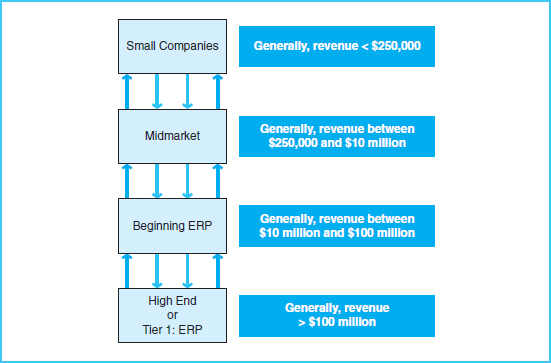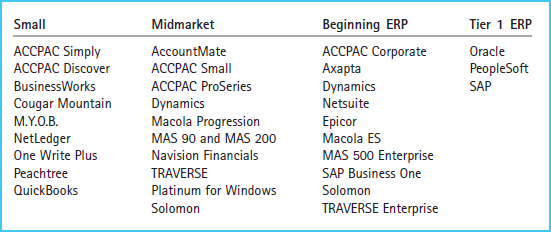ACCOUNTING SOFTWARE MARKET SEGMENTS (STUDY OBJECTIVE 5)
The accounting software market today is categorized into four market segments: small company systems, midmarket company systems, beginning ERP systems, and tier 1 ERP systems. Each segment is based on the size of the organization in terms of the amount of its revenue.
THE REAL WORLD
Hawaii Commercial Real Estate Company of Honolulu is a realty and property leasing organization specializing in the sales, leasing, and financing of office buildings, hotels, retail centers, industrial buildings, and investment properties. The success of the company depends on the relationships it builds and its ability to track both clients and properties and the different data associated with each. To improve the efficiency of its operations, Hawaii Commercial Real Estate has created several databases using ACT! Premium Solutions by Sage Software. ACT! provides a host of Web-based productivity tools such as scheduling, social media, e-mail, and database management. For Hawaii Commercial Real Estate, there are customized tabs and data fields to manage all aspects of its business, from sales reporting and sharing notes about current and prospective clients, to launching new advertising efforts. The ACT! system is integral to everyday business and is flexible enough to accommodate remote Web access for agents when they are away from their desks.
Exhibit 2-3 illustrates the four software market segments. Within this hierarchy of market segments, a company with revenue of $200,000 would probably be classified within the small companies market segment, and would therefore be likely to purchase accounting software that fits in that segment. On the other hand, a large, Fortune 500 corporation might purchase accounting software systems in the tier 1 market segment—that is, an ERP system. Most software vendors attempt to increase the appeal of their software to more than one market segment, however, so understanding this market segmentation can be difficult. As an example, while Intuit's Quickbooks has traditionally been sold to small companies, its new software product, Quickbooks Enterprise, is intended to appeal to companies in the midmarket segment.
Exhibit 2-3 The Accounting Software Market Segments and Movement in the Market

As accounting software development companies attempt to reach other market segments, the differentiation between products becomes blurred. Therefore, not all accounting software systems fit neatly into a single segment.
Exhibit 2-4 illustrates some of the most popular accounting software systems in each of the four market segments that they most closely fit. Often these software solutions are chosen to more fully integrate business processes across the organization.
The programs listed in Exhibit 2-4 are based on modern technology, and each attempts to integrate many business processes into a single software system. The vendors continue to update these software systems to take advantage of e-commerce, e-business, and integration across business processes. Therefore, even those software systems in small and midmarket segments are becoming more like ERP systems. As described in Chapter 1, ERP systems are multimodule software systems designed to manage all aspects of an enterprise and ERP are usually broken down into modules such as financials, sales, purchasing, inventory management, manufacturing, and human resources. The modules are designed to work seamlessly with the rest of the system and to provide a consistent user interface across modules. Based on a relational database system, ERP systems usually have extensive setup options that allow some flexibility in customizing their functionality to specific business needs.
Many of the software systems in the small and midmarket categories are not true ERP systems in that their modules are not fully integrated as an ERP system would be; the companies that develop and sell these software systems try to assimilate the features of ERP systems. This trend is likely to continue in the future as technological advances allow software development companies to build ever-increasing power and functionality in the software products they offer.
Because of their size and the many complex processes that make up their businesses, large, multinational corporations have specific needs for accounting software systems. The most widely used tier 1 ERP system for large corporations is SAP. A small sample of the many well-known companies using SAP includes Anheuser-Busch, Daimler-Chrysler, Coca-Cola, Exxon, H.J. Heinz, Reebok, and Rubbermaid.
Exhibit 2-4 Popular Accounting Software Programs within the Market Segments

Regardless of the type of accounting software used, computer processing is involved in the input of data, the processing of that data, and the outputs from the system. The next section describes many of the input and processing methods used in IT systems today. In addition, the types of outputs produced are described.
